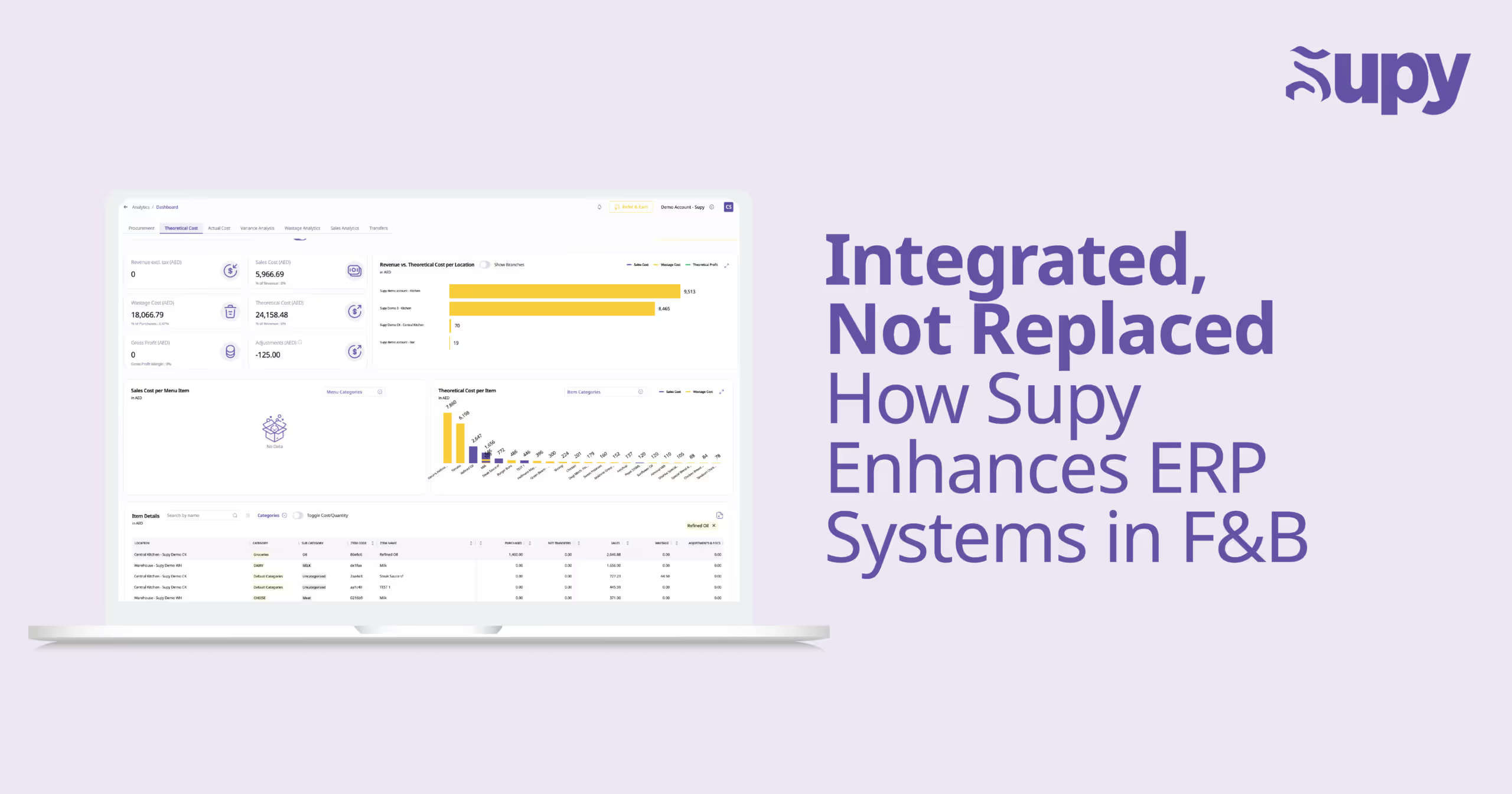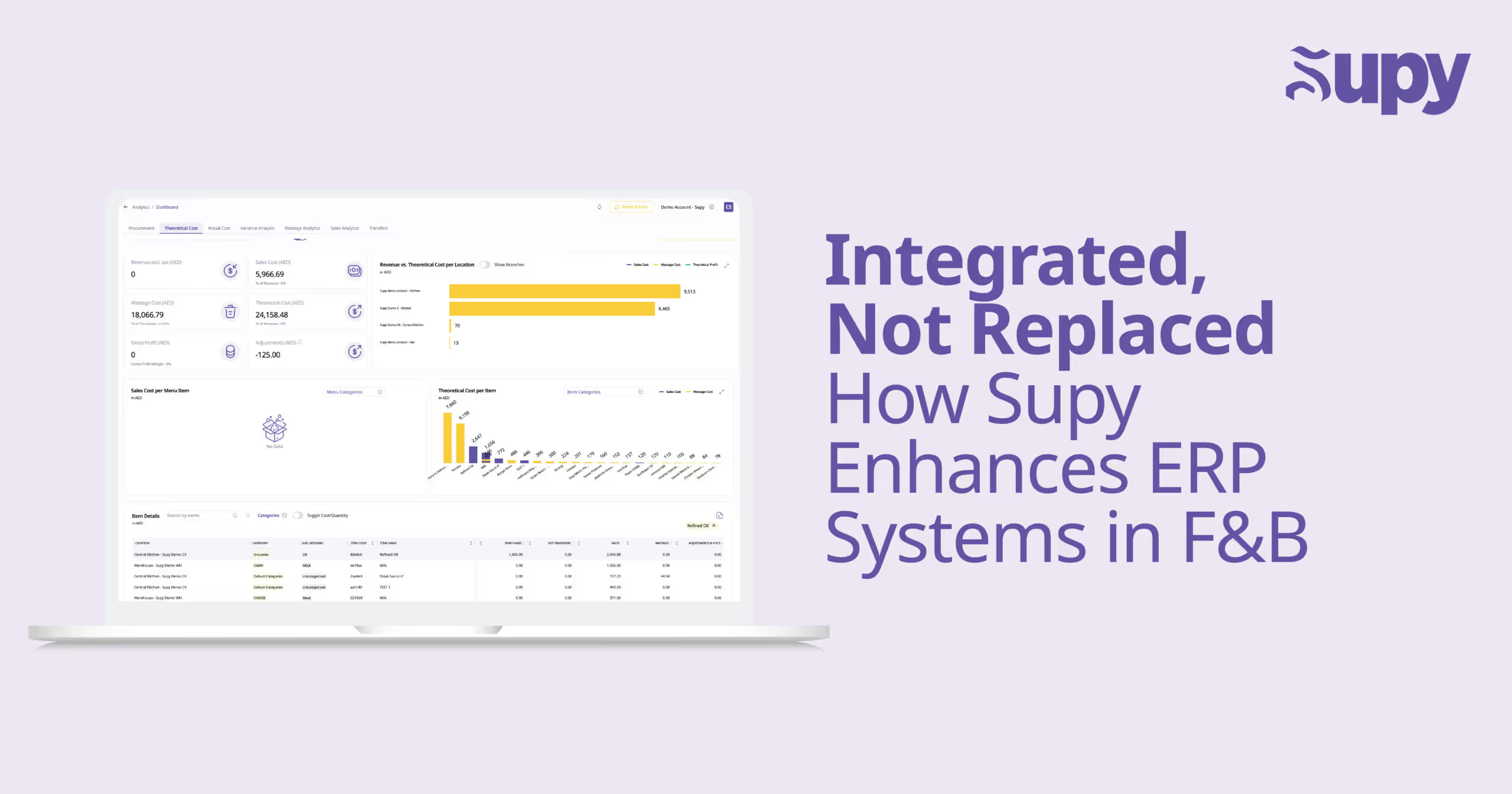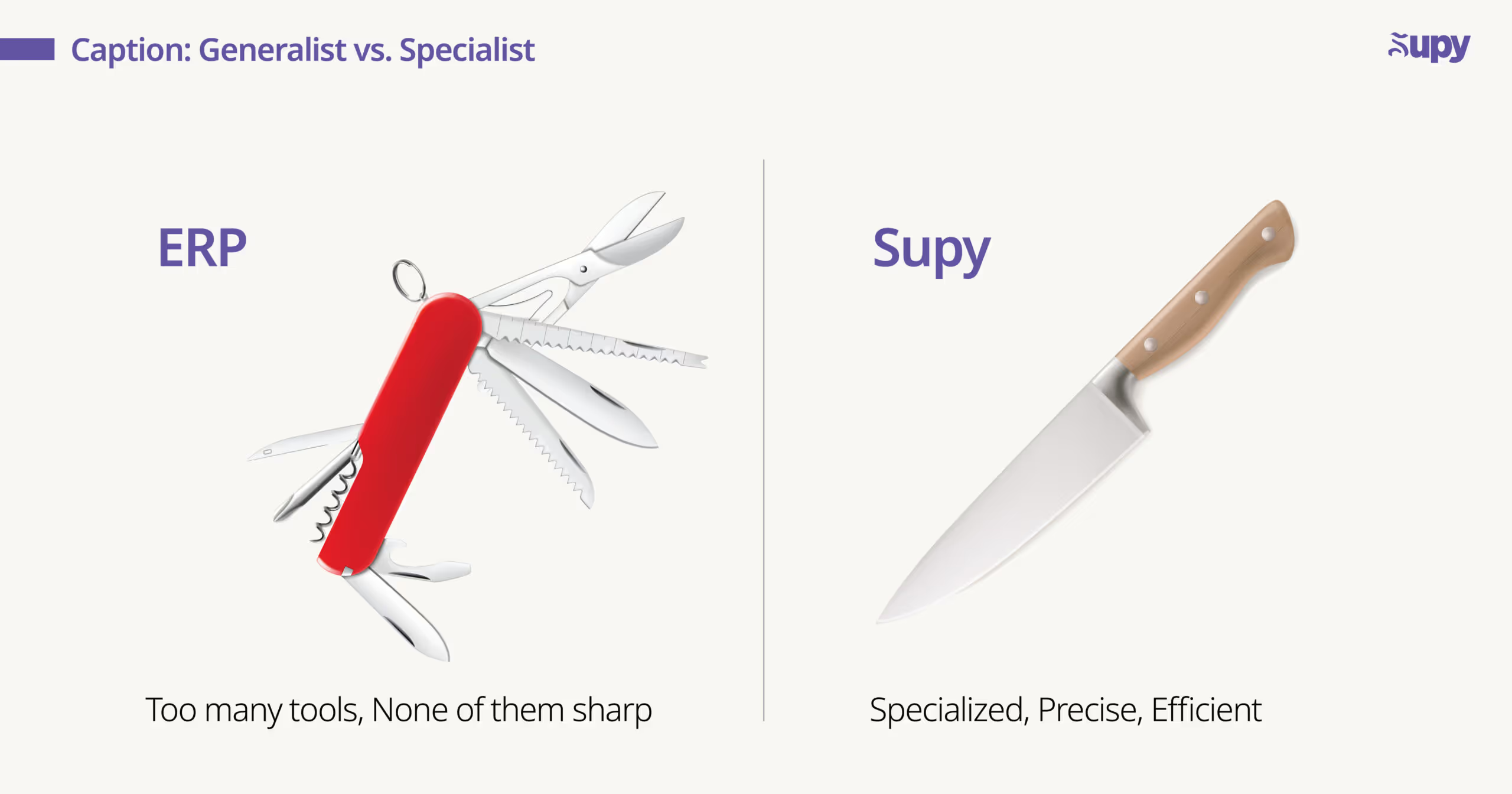Integrated, Not Replaced: How Supy Enhances ERP Systems in F&B


Integrated, Not Replaced: How Supy Enhances ERP Systems in F&B
When restaurant groups invest in ERP systems, it feels like the entire business is covered, finance, HR, procurement, even inventory. One system, one vendor, full control.
But here’s the reality: ERPs weren’t built for the fast, messy, margin-sensitive world of restaurant operations.
Trying to make your ERP do what Supy does, track real-time food cost, manage live stock levels, run mobile stock counts, and standardise recipes, means custom development, complex workflows, and six-figure consulting bills.
Supy solves that instantly, and at a fraction of the cost.
It doesn’t replace your ERP, it upgrades it. With better tools, better UX, and a faster path to margin control.
Here is how.
ERPs Are Built to Be Everything. That’s the Problem.
ERPs are generalists. By design.
They’re built to serve every industry, from logistics to manufacturing to F&B. That flexibility is their strength, but also their greatest weakness.
There’s no recipe module. No dish-level costing. No real-time food cost tracking. And certainly no understanding of how kitchens actually function day to day.
Supy is built differently. It’s purpose-built for restaurants.
That means every screen, every workflow, and every feature is designed for the realities of F&B, not manufacturing, not e-commerce. Hospitality.

You Don’t Need to Choose One or the Other, Use Both
This isn’t about ERP vs. Supy. It’s about using the right tool for the right job.
- Let your ERP handle accounting, HR, and high-level reporting.
- Let Supy power your back-of-house, procurement, inventory, wastage, recipe costing, and supplier management.
Trying to retrofit your ERP to handle restaurant operations doesn’t just slow you down, it gets expensive.
We’ve seen operators spend tens of thousands of dollars building custom modules, hiring consultants, and waiting months for changes that still don’t match how their teams work.
And even then, they’re left with rigid workflows, clunky interfaces, and staff that never fully adopt the system.
Supy is the alternative.
It’s built specifically for F&B, integrates seamlessly with your ERP, and gives your team what they actually need, without the six-figure implementation bill.
You don’t need to force your ERP to do what it wasn’t designed to do.
You just need the right tool beside it.
Why Restaurant Groups Choose Supy Alongside Their ERP

Here’s what actually happens when operators use Supy and an ERP together:
- Real-time data replaces end-of-month reports.
You don’t wait 30 days to see that your chicken shawarma recipe is 8% over cost. Supy shows you that today, and lets you fix it before it hits your margins. - Stock counts, waste tracking, GRNs, all done from a mobile phone.
No laptops in the kitchen. No delays. No manual entry. - Live food cost and margin data at the recipe level.
When ingredient prices shift, Supy updates your recipe costing immediately. ERPs simply can’t do that. - Simplified procurement workflows with approvals and price discrepancy alerts.
Operators know exactly what was ordered, received, and what it cost, down to the last line item. - Seamless integration with your ERP.
Supy pushes clean data to your ERP, so your finance team gets the insights they need without manual reconciliation. - Superior UX for operators.
Stock counts feel like using a modern app, not filling out a government form. Approvals happen with a tap. Data makes sense at a glance.
Most ERP interfaces are clunky, built for desktops and back-office teams. Supy is fast, mobile-first, and designed for the people on the ground.
The Misconception: “Our ERP Has Inventory Built In”
Yes, it does. But so does Excel. That doesn’t make it the right tool.
Inventory isn’t just something you do. It’s how you control cost, reduce waste, and protect your margins.
Done right, it reduces waste, increases margins, and tightens control across every location.
But most restaurant groups don’t realise this, until it’s too late. Until they’ve invested in ERP modules they don’t use, and built custom workflows that still don’t fit how their kitchens actually operate.
A Real-World Example
Without naming names, we’ve seen large operators roll out ERP systems only to realise, within months, that they couldn’t track cost of goods accurately, or implement stock counts consistently.
Once Supy was introduced alongside the ERP, they gained:
- Accurate, real-time COGS
- Faster stock counts across locations
- True insight into recipe-level profitability
- More confident procurement decisions
ERPs Are for the CFO. Supy Is for the Ops Team.
Supy isn’t trying to replace your ERP.
It’s the layer underneath that keeps your operation running smoothly, so that what reaches your ERP is clean, reliable, and actionable.
Your ERP gives you a bird’s-eye view.
Supy gives you boots on the ground.
Final Thought: Built for Restaurants. Not for Everyone.
ERPs are designed to serve everyone. Supy is designed to serve one thing: food businesses.
That’s why it integrates better, trains faster, and delivers ROI from week one.
If you're running an ERP and wondering whether it’s enough, it’s probably not.
But you don’t need to rip it out. You just need to plug in the system that actually speaks restaurant.
That’s Supy.







